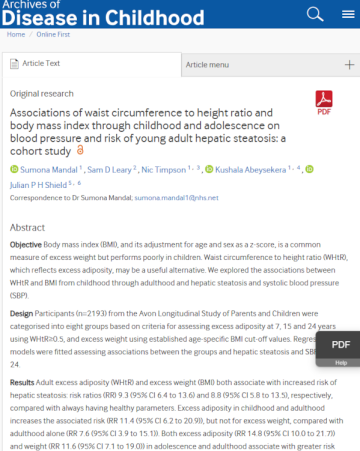Childhood waist to height ratio may be an equally good predictor as BMI of liver disease and high blood pressure in young adults
- 11 June 2025
How a child’s waist size compares to their height may be an equally good tool to predict serious health problems later in life, including liver disease and high blood pressure, as traditional body mass index (BMI) according to a new study. The National Institute for Health and Care Research (NIHR) supported study is published in BMJ Archives of Disease in Childhood.
BMI isn’t always a reliable measurement in childhood. It doesn’t differentiate between body fat and muscle mass. Children’s BMI will vary as they grow. The research team wanted to investigate whether other measures could be as effective.
Researchers from the Avon Longitudinal Study of Parents and Children and the NIHR Bristol Biomedical Research Centre (BRC) followed more than 2,000 participants from childhood into early adulthood. They found that children and teenagers with a high waist-to-height ratio (WHtR) – a measure that reflects abdominal fat – were more likely to develop hepatic steatosis (also known as fatty liver disease) and elevated blood pressure by age 24. This was especially the case if their high waist measurement continued into adulthood.
While BMI is commonly used to assess whether a child has a higher weight, it doesn’t always accurately reflect body fat or how it’s distributed. WHtR, on the other hand, focuses on abdominal fat, which is known to have a closer link to certain health risks.
The study found that young adults with excess waist size to height, had up to 9 times the risk of developing liver disease compared with those who maintained healthy levels through to early adult life. But those who had excess WHtR or BMI in childhood through to early adulthood were at even higher risk: about 15-times the risk compared to always having healthy levels.
The findings highlight the long-term health effects of childhood weight and body shape. The researchers say WHtR could offer a simpler and potentially more effective way to identify children at higher risk of future health problems.
Dr Sumona Mandal, lead author of the study and Radiology Registrar at St George’s Hospital, London, said:
“Tools to spot at-risk children early help us intervene before serious conditions like fatty liver disease and high blood pressure develop. Waist-to-height ratio seems a good alternative to BMI, being easier to measure and use.”
The researchers suggest WHtR might be especially useful in schools or clinics, where a quick and easy measure of risk could help guide early health interventions.
